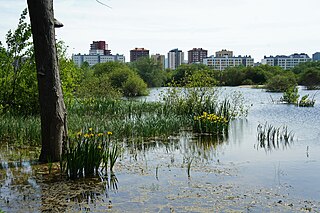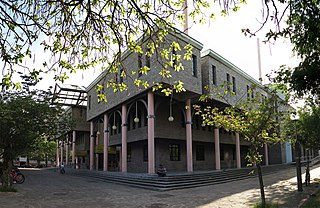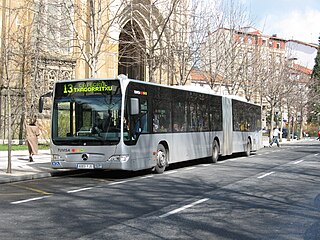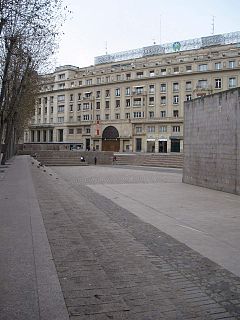
Vitoria-Gasteiz, also alternatively spelled as Vittoria in old English-language sources, is the seat of government and the capital city of the Basque Country and of the province of Álava in northern Spain. It holds the autonomous community's House of Parliament, the headquarters of the Government, and the Lehendakari's official residency. The municipality—which comprises not only the city but also the mainly agricultural lands of 63 villages around—is the largest in the Basque Country, with a total area of 276.81 square kilometres (106.88 sq mi), and it has a population of 253,093. The dwellers of Vitoria-Gasteiz are called vitorianos or gasteiztarrak, while traditionally they are dubbed babazorros.

Euskotren Tranbia is the brand under which the tramway networks in the cities of Vitoria-Gasteiz and Bilbao are run. The system in Bilbao started operations in 2002, and the one in Vitoria-Gasteiz in 2008. It is one of the four commercial divisions under which Euskotren operates. The infrastructure is owned by the public entity Euskal Trenbide Sarea and tracks use 1,000 mm narrow gauge.

The University of the Basque Country is a Spanish public university of the Basque Autonomous Community. Heir of the University of Bilbao, initially it was made up of the Faculty of Economic and Business Sciences of Sarriko (1955), Medicine (1968) and Sciences (1968). Following the General Law of Education (1970), the Nautical School (1784), the School of Business Studies of Bilbao (1818) and the Technical Schools of Engineers (1897) joined in, until it grew into the complex of thirty centers that compose it presently.

Basque Y is the high-speed rail network being built between the three cities of the Basque Autonomous Community, in Spain; Bilbao, Vitoria-Gasteiz and Donostia-San Sebastián.

The Basque Country, also called Basque Autonomous Community, is an autonomous community of Spain. It includes the provinces of Álava, Biscay, and Gipuzkoa, located in the north of the Iberian Peninsula, bordering on the autonomous communities of Cantabria, Castile and León, La Rioja, and Navarre, and the French region of Nouvelle-Aquitaine.
The park of Armentia, commonly known as "El bosque de Armentia", is a gall-oak forest located between Vitoria-Gasteiz and the Mountains of Vitoria, in the province of Álava and of the autonomous community of the Basque Country in northern Spain. It has a surface area of 165 has and it is one of the main biological areas in the surroundings because it has a variety of flora and fauna.

The Green Belt of Vitoria-Gasteiz is a set of urban parks with high ecological value, strategically linked by eco-recreational corridors. It is the result of an ambitious plan of restoration and reclamation on the outskirts of the city that seeks to recover the ecological and social value of this space through the creation of a nature tour around the city articulated by various enclaves of high ecological value and landscape. It is the result of a project which began in the early 1990s and was selected by the UN among the 100 best global performances of the III International Competition "Best Practices for improving the living conditions of the cities", held in Dubai in the year 2000. Currently, it has five established parks: Armentia, Olarizu, Salburua, Zabalgana and Zadorra.

Salburua is a wetland habitat on the eastern outskirts of the city of Vitoria-Gasteiz in the Basque Country in Spain. The area, which is part of the city green belt, contains lakes, meadows and oak groves. It was drained in the 19th century to transform the area into farmland. Restoration work started in 1994 and has reversed this situation and now Salburua is a Ramsar Wetland of International Importance. The Salburua marshes are considered to be "the Basque country's most valuable area of wetland", according to a Fedenatur report for the European Commission in 2004.

Betoño is a village in Álava, Basque Country, Spain.

The Cathedral of Santa María de Vitoria is a Gothic-style, Roman Catholic cathedral located in Vitoria-Gasteiz, Basque country, Spain. It was declared Bien de Interés Cultural in 1931.
Tourism in the Basque Autonomous Community has increased considerably in recent years. According to data from the Eustat the number of tourists entering the region in the year 2009 was 1,991,790, with the final result still pending. 71% of the yearly visitors come from the rest of Spain; the greatest number from Madrid Autonomous Community (14.2%), and Catalonia (11.1%). International visitors make up the remaining 29% - the largest percent come from France (7.2%). 62% of the people who come to the Basque Autonomous Community visit one of the three capitals, 27% visit inland and 11% visit the coast. The average stay of the visitors is 2 days.

Conservatorio Jesús Guridi is a music academy in Vitoria-Gasteiz, Spain. It is called Jesús Guridi due to the famous Basque musician who was born in Vitoria-Gasteiz. The conservatory is located in Vitoria-Gasteiz, capital of the Autonomous Community of the Basque Country. With a population of 220.000 citizens, the city has a very big cultural dynamism and a particular interest at the moment of offering different artistic and cultural activities. That is why the city contains a large number of museums and a complete programming of cultural events during the whole year, organized by the public institutions and the private leadership. Actually Jesús Guridi music conservatory occupies a very important place in the cultural life of the city.

The Abetxuko Bridge is a steel girder bridge with organic forms in Vitoria-Gasteiz, Álava, Basque Country, Spain.

TUVISA is the municipal company responsible for urban transport in the city of Vitoria-Gasteiz, in the north of Spain. As of March 2022, the company operates 97 buses.

The Reservoir of Ullíbarri-Gamboa is located next to the villages Ullíbarri-Gamboa, Nanclares de Gamboa and Arroiabe in Álava, Basque Country, Spain. It has a volume of 146 hm³ and this makes it the biggest reservoir in the Basque Country. The area of land all around the reservoir is called Arratzua-Ubarrundia and it is famous for its routes for tracking.

The Plaza de los Fueros is a plaza or square located in the city centre of Vitoria-Gasteiz, which is the capital of the Basque Country, Spain. It was built in 1979 in memory of the county code of laws named fuero in Spanish.
Mariano Bayón Álvarez is a Spanish architect.
















